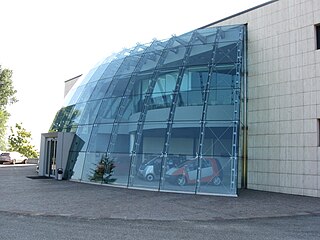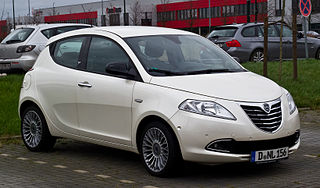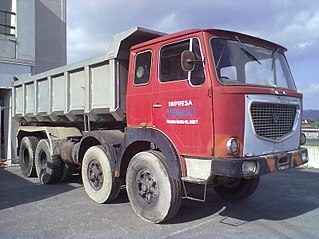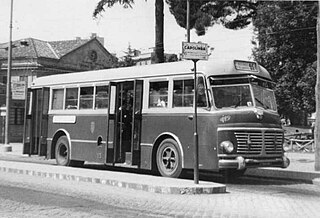This article needs additional citations for verification .(July 2012) |
Lancia E290 is an Italian electric truck produced from 1941 to 1947 from Lancia.
This article needs additional citations for verification .(July 2012) |
Lancia E290 is an Italian electric truck produced from 1941 to 1947 from Lancia.
The truck is used during 2nd World War.
The maximum speed on the truck is 30 km/h (19 mph) and the transmission is 4x2. The emissions are 0 g/km. The weight of the Lancia E290 is around 5 t.
From the electric version 61 examples were produced. In total 202 electric trucks were built (E290 + E291). After the war, some were modified to run with petrol engines.
Iveco S.p.A., an acronym for Industrial Vehicles Corporation, is an Italian multinational transport vehicle manufacturing company with headquarters in Turin, Italy. It designs and builds light, medium, and heavy commercial vehicles. The name IVECO first appeared in 1975 after a merger of Italian, French, and German brands. Its production plants are in Europe, China, Russia, Australia and Latin America and it has about 5,000 sales and service outlets in over 160 countries. The worldwide output of the company amounts to around 150,000 commercial vehicles with a turnover of about €10 billion.

Lancia Automobiles S.p.A. is an Italian car manufacturer and a subsidiary of Stellantis Europe, which is the European subsidiary of Stellantis. The present legal entity of Lancia was formed in January 2007 when its corporate parent reorganised its businesses, but its history is traced back to Lancia & C., a manufacturing concern founded in 1906 in Torino by Vincenzo Lancia (1881–1937) and Claudio Fogolin. It became part of Fiat in 1969.

A diesel–electric transmission, or diesel–electric powertrain, is a transmission system powered by diesel engines for vehicles in road, rail, and marine transport. Diesel–electric transmission is similar to petrol–electric transmission, which is powered by petrol engines.

The Ford River Rouge complex is a Ford Motor Company automobile factory complex located in Dearborn, Michigan, along the River Rouge, upstream from its confluence with the Detroit River at Zug Island. Construction began in 1917, and when it was completed in 1928, it was the largest integrated factory in the world, surpassing Buick City, built in 1904.

Pininfarina S.p.A. is an Italian car design firm and coachbuilder, with headquarters in Cambiano, Turin, Italy. The company was founded by Battista "Pinin" Farina in 1930. On 14 December 2015, the Indian multinational Mahindra Group acquired 76.06% of Pininfarina S.p.A. for about €168 million.

Crude ideas and designs of automobiles can be traced back to ancient and medieval times. In 1649, Hans Hautsch of Nuremberg built a clockwork-driven carriage. In 1672, a small-scale steam-powered vehicle was created by Ferdinand Verbiest; the first steam-powered automobile capable of human transportation was built by Nicolas-Joseph Cugnot in 1769. Inventors began to branch out at the start of the 19th century, creating the de Rivaz engine, one of the first internal combustion engines, and an early electric motor. Samuel Brown later tested the first industrially applied internal combustion engine in 1826. Only two of these were made.

The Lancia Ypsilon is a supermini (B-segment) manufactured and marketed by Lancia, currently in its fourth generation and as of 2024, the marque's only model. The Ypsilon was released in 1995, as a larger and more expensive replacement to the Y10. Between 1995 and 2005, Lancia produced more than 870,000 Ypsilons in the Melfi plant in the Potenza region.

The Lancia Ardea is a small family car produced by Italian car manufacturer Lancia between 1939 and 1953. Its unusually short bonnet reportedly contained the smallest V4 engine ever commercialized in a small family car.

Smith Electric Vehicles is a manufacturer of electric trucks. The company, founded in 1920 in the north of England, moved its headquarters to Kansas City, Missouri in 2011. Smith suspended all operations in 2017.
The Lancia Ro, Lancia Ro-Ro and Lancia 3Ro were 4x2 heavy trucks built by Italian manufacturer Lancia from the 1930s through the 1940s for military and civilian use. The 2-cylinder diesel Ro was produced from 1933 to 1939, the 3-cylinder diesel Ro-Ro from 1935 to 1939 and the improved 5-cylinder diesel 3Ro from 1938 to 1947.

Lancia Esagamma is a truck and bus chassis produced by Italian car manufacturer Lancia from 1962 to 1973.

The Lancia Superjolly is a light commercial vehicle produced by the Italian manufacturer Lancia. The truck, which shares its 815.000 engine and some other mechanicals with the Lancia Flavia, is the successor of the Appia-based Lancia Jolly. The 1½ ton Superjolly has a longer wheelbase than its predecessor. The little truck was produced from 1963 to 1970 in Turin, Italy. The first model (315.000) was produced in 1674 examples, while 1272 of the 1.8-litre 315.024 model meant that overall production was 2948. The Superjolly has front-wheel drive with independent suspension, meaning that the loading area is uncommonly low. The subframe and drivetrain of the Flavia were used, with some modifications to handle heavier work, but the Superjolly also utilized parts from the Appia, Fulvia, and Flaminia ranges.Manual transmission was standard.

Lancia Esatau is a series of truck and bus chassis produced by Italian manufacturer Lancia Industrial Vehicles from 1947 to 1973. 13,362 examples were produced.

Lancia 140 is an Italian trolleybus produced from 1967 to 1968. The vehicles are double decker. Until 1995 trolleybuses of this model were used in Porto, Portugal. This trolleybus had two doors. The electrical equipment was from CGE, and the body, with 58 seats, from Dalfa. 50 units were built.
The Lancia Trijota is one of the first buses produced by the Italian vehicle manufacturer Lancia. The bus was produced from 1921 to 1925.

The Lancia Jota is a series of truck and bus chassis produced by Lancia between 1915 and 1935. The original 1915 Jota was the first true Lancia truck; throughout the following two decades it was made in a number of different series and variants, each identified by a progressive Greek numeral prefix added to the name, from Djota to the last Eptajota. While axle tracks, wheelbase and equipment gradually grew, the original layout and 4,940 cc four-cylinder petrol engine were retained.
Lancia Esadelta is an Italian truck produced from 1959 to 1971.

Boulder Electric Vehicle was a manufacturer of electric-powered commercial vans and trucks based in Lafayette, Colorado. The company produced four CARB-certified models: an electric delivery van, a 15-passenger shuttle, a service body and a flat bed. Boulder Electric Vehicles ended production in September 2014.

The automobile industry in Poland makes up a sizeable part of the Polish economy, accounting for about 11% of Poland's industrial production. Poland is one of the largest producer of light vehicles in Central and Eastern Europe. As of 2013 Poland was the 23rd largest automaker in the world.
The Lancia 1Z was a light military truck produced by Italian manufacturer Lancia between 1912 and 1916. From a mechanical standpoint, it was closely related to the 1913 35 HP Theta passenger car. It was Lancia's first military vehicle.